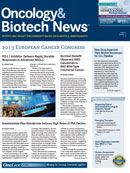Provocative Questions: A "Cancer To-Do List"
As we approach the end of the year, it is a reasonable time to reflect on what has been accomplished in cancer research and therapeutic development.
Andrew L. Pecora, MD
Editor-in-Chief of Oncology & Biotech News
Chief Innovations Officer, Professor, and Vice President of Cancer Services John Theurer Cancer Center at Hackensack University Medical Center
President, Regional Cancer Care Associates, LLC
As we approach the end of the year, it is a reasonable time to reflect on what has been accomplished in cancer research and therapeutic development. Over the past year, I have attempted to highlight the clinical, scientific, and business forces that together are molding the pace and direction of cancer discovery and care delivery. A recent article in the journal Science (2013;342[6157]:416-419) calls attention to the future direction of cancer discovery and care, and is deserving of your attention.
The article points out that, despite a shrinking budget, the current director of the National Cancer Institute (NCI), Noble Laureate Harold Varmus, MD, is responsible for setting the funding priorities and thus the direction of cancer research in the United States, with obvious global impact and continued expectations of advancement.
In addition to a Nobel Prize for the discovery of proto-oncogenes (awarded in 1989; Physiology/ Medicine) he would appear to be ideally suited for directing national funding based on his experience in directing the National Institutes of Health (1993-1999) and Memorial Sloan-Kettering Cancer Center (2000-2010)—not bad for someone who was an English major in college!
Under Dr Varmus’s leadership, the NCI launched the Provocative Question initiative. Over $35 million in grants have been awarded so far through the program, addressing a diverse group of questions broken into five categories. These include Cancer Prevention and Risk; Mechanisms of Tumor Development or Recurrence; Tumor Detection, Diagnosis, and Prognosis; Cancer Therapy and Outcomes; and Clinical Effectiveness.
These groups cover the gambit of human behavior, physiology, tumor biology, and intervention. Common to all the questions is why do cancers occur more commonly in some (Global Cancer) and respond to the same therapy differently. As one would expect, searching for molecular pathways that confer disease properties and sensitivities to therapy is core (The Cancer Genome Atlas). Of note is an emphasis on the human immune system, its state and the state of malignancy and response to therapy. The importance or lack thereof to early detection and the relevance of cancer stem-cell biology is addressed. In contrast, both patient behavior that relates to cancer cause and outcome and physician behavior that influences cancer outcomes and cost are addressed.
Included is the “needle-in-a-haystack” approach of calling out unusual and unexpected outcomes like complete response to therapy that usually are marginally effective (exceptional responders) to search for molecular signals that are predictive or even better drivers of the response (Unconventional Trial).
To use a Western metaphor, it would appear that Dr Varmus is circling the wagons around the entirety of cancer and plans to attack it from all directions. Having been an observer and participant of the cancer story since 1984, it is heartening to see the field now firing on all cylinders with the goal of President Nixon’s declaration of a War on Cancer entering its final chapter.




